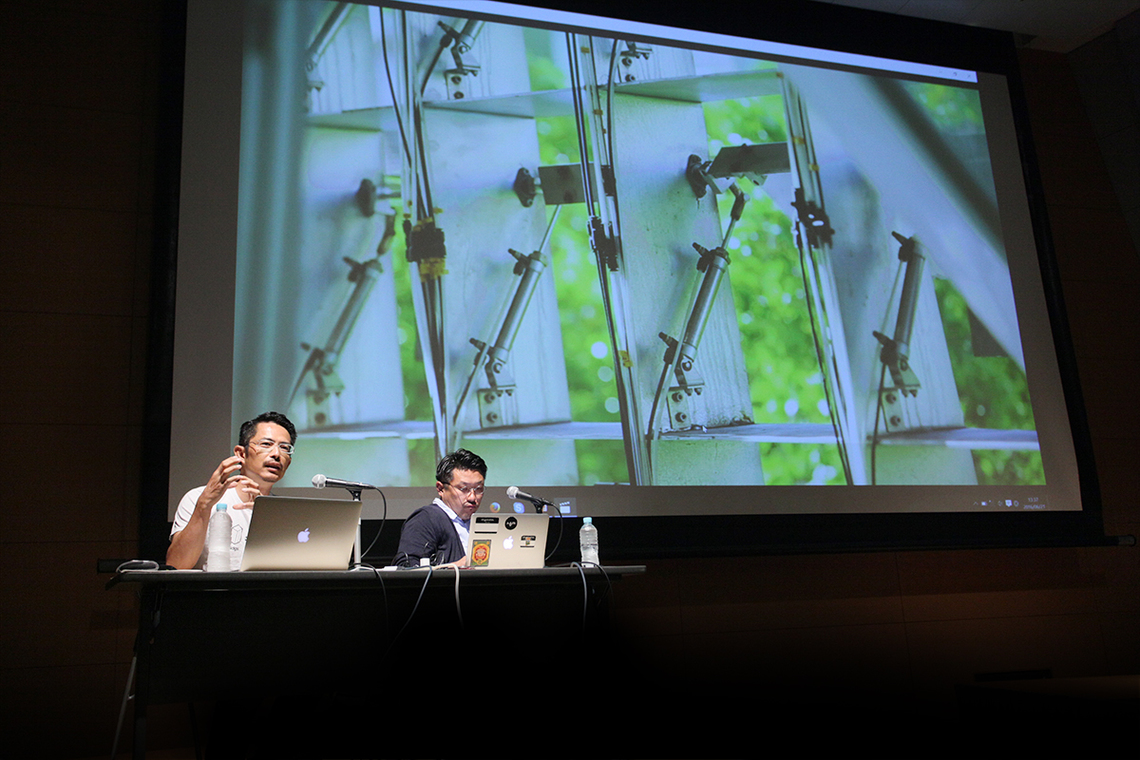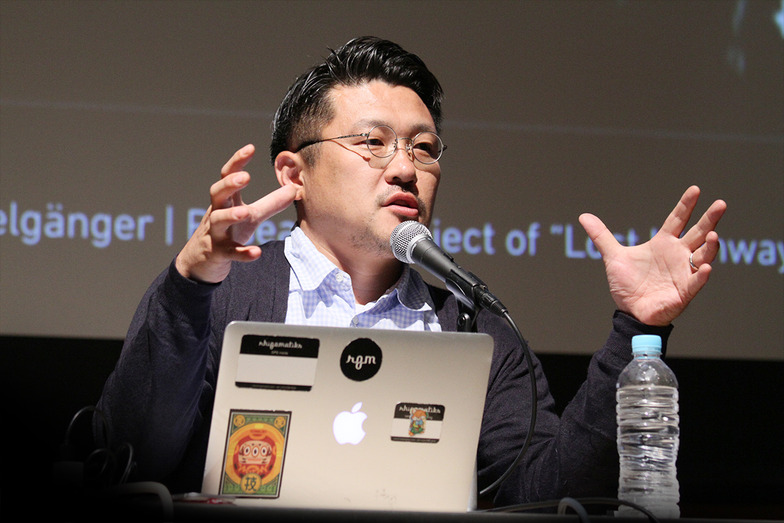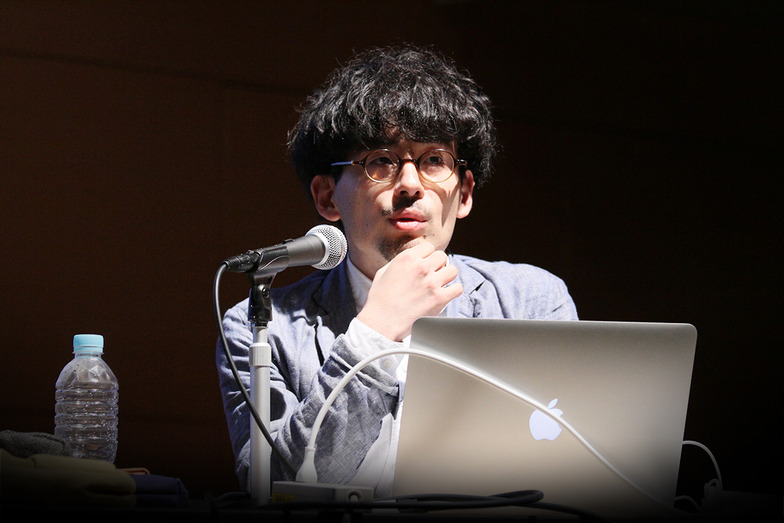As an IoT-enabled society becomes increasingly realized, cross-disciplinary work is accelerating within the architecture field. The pervasive digital network has finally permeated and integrated with the realms of space and architecture. Consequently, the architect's role is shifting from conventional building, structural, and design work toward more organic expression and collaborative creation with professionals outside the industry. This Design Talk featured Seiichi Saito, who founded Rhizomatiks after working as an architect and launched the architecture division "Rhizomatiks Architecture" following experiments in business using various arts and technologies, and Keisuke Toyoda of noiz architects, who is gaining prominence as a leading figure in "computational architecture "Rhizomatiks Architecture." Dentsu Inc. Event & Space Design Bureau's Yu Nishimuta hosted the discussion on the theme "Adaptive Architecture," exploring visions for the future. Here is the second part.

(From left) Mr. Toyoda, Mr. Saito
How will IoT transform the future of architecture and cities?
Nishimuta: To explore your visions for the future of architecture and cities, I've prepared some keywords. IoT is gaining significant attention. What changes do you foresee when this trend intersects with architecture and urban planning?
Saito: Architecture is fundamentally inseparable from economics, law, politics, and so on. But I feel that until now, the stance has been that once the building permit process was complete, it was no longer relevant. I sense that IoT could be the catalyst for creating a common language across various industries and sparking a movement to reconnect them. Incidentally, what I believe most urgently needs IoT integration right now are "items sleeping in warehouses" and "human memories." Cassette tapes, photographs, documents... all this history and memory lying dormant, undigitized. Unless these are digitized, true IoT integration won't advance. This is where I want to dive in first regarding IoT.
Toyota: I once conducted joint research with an appliance manufacturer on what home appliances would look like in 10 years. We discussed how packaging sensors into individual appliances would be wasteful, suggesting instead embedding shared sensors throughout the home. I believe the same principle applies at the scale of buildings and cities. So, rather than focusing on individual IoT products, the real challenge lies in how we process the data collected from them to create infrastructure and software that can address complex needs or enable intelligence. That's far more challenging—and far more interesting.
We're currently exploring opportunities to apply this at small scales, like in mixed-use facilities and large shopping malls. But if we were to take it all the way to software development, that would definitely go beyond the scope of an architecture firm... Where should we go from here?
Saito: It can't be done by architects alone, developers alone, or consultants alone. At the building level, architects can take the initiative, but at the city level, the locus of initiative shifts, right? Someone with a bird's-eye view of society must connect the concept and the content. In terms of having that bird's-eye perspective, the advertising industry is quite close. They grasp consumer trends, societal shifts, and technological developments. They can even connect disparate industries like housing manufacturers and Google.
Nishimuta: If there were a function to effectively connect people from various fields, the character of the city would change, wouldn't it?
Toyoda: When digital technology becomes the foundation for building maintenance, content and systems will also change. Design will shift from three-dimensional work to encompassing time, becoming four-dimensional. However, the concept and know-how of properly designing and presenting this as a package doesn't yet exist in the architecture world. I find it fascinating to shape this into a form that can be handled and turned into value; I believe this will be a key monetization point.
Saito: We're tackling operational challenges right now. We're considering questions like: What kind of team should manage the space? How can tenants be physically present while simultaneously being stored in e-commerce? Operations are most closely tied to monetization. For example, in municipalities, subsidies often get cut off, or projects collapse when the responsible government official transfers. I believe creating a self-sustaining system can solve these issues.
How Technology Will Transform Public Spaces
Nishimuta: How can we utilize public spaces like parks? There seems to be a trend toward relaxing regulations, and the very nature of public spaces appears to be changing. How do you think technology will transform these public spaces?
Saito: I recall a great architect once saying, "The greatest pleasure of walking through a city is seeing if a beautiful woman is waiting around the corner." That really stuck with me. Currently, the communication layer of technology doesn't quite align with the physical layer of the city, but they will converge. When that happens, the experience of turning a corner and encountering a beautiful woman might become something we experience digitally. On the other hand, considering what technology might eliminate from the city, things like mailboxes and utility poles will likely be phased out. If that happens, we might ultimately return to the primal landscape of an era with nothing. Perhaps the very heart of Tokyo could become a pastoral scene. The image closest to my mind is from the anime film "Summer Wars," where a supercomputer is placed in a tatami room, cooled by ice. As technology evolves, I think we might approach that kind of form.

Toyoda: I grew up on reclaimed land, so I have a deep fascination with old settlements. Settlements and cities are built up through the accumulated will and time of thousands of people; they aren't something you can control and create like reclaimed land. Settlements have an overwhelming fascination born from the accumulation of things beyond control. Until now, we could only accept them as given results. But technology has opened the possibility of indirectly designing such ambiguous accumulations. It feels like we're starting to reach into the next dimension, and I'm incredibly excited. When we gain control over settlements and cities—these accumulative phenomena once deemed impossible—what will we be able to do? How will a designer's sensibility and functionality change? I'm deeply interested and want to take the lead in experimenting myself.
Nishimuta: Finally, could you tell us about your upcoming challenges?
Toyoda: As mentioned earlier, I want to create a platform to commercialize new architecture research and consulting separate from noiz. We're preparing a platform that can take on projects—including implementation—that previously involved sporadic research or consulting, while welcoming people from various fields.
Saito: Personally, I aim for "non-disciplinary thinking" – thinking across fields. To achieve this, "protocols" are absolutely essential. Without them, even within the same company, departments can't communicate. Connecting these gaps is precisely the work of those involved in expression and systems like advertising. 2020 will be a major catalyst for this, and I believe it's the perfect time to build this platform. I'm personally passionate about the idea that if everyone adopts a single protocol and works with the mindset of connecting architecture, cities, and surrounding industries, things will start to change.
Nishimuta: Dentsu Inc. Event & Space Design Bureau is also embarking on new challenges. Together with Rhizomatiks and TYO, we've launched a new urban development project called the "Ultra Public Project."
Nishimuta: This urban development project involves taking a soft approach: first envisioning what the future of the city should be like for its residents and visitors, not through hard approaches like land division or building construction, but by considering it with the "clear eyes" of an ordinary citizen. Then, we tackle it by leveraging our team's expertise in "Technology × Entertainment." We plan to paint a picture of the city's future from the unique perspective of the Ultra Public Project and conduct proof-of-concept experiments to realize it.
I hope our activities can become one of the "platforms" Mr. Saito mentioned.
Nishimuta: By rethinking existing concepts and approaches from fresh perspectives, engaging diverse people, and expanding boundaries, we unlock endless possibilities. Today, we heard stories that hint at such a future. Thank you very much.
<End>
You can also read the interview here on AdTie!
Planning & Production: Aki Kanahara, Dentsu Inc. Event & Space Design Bureau








